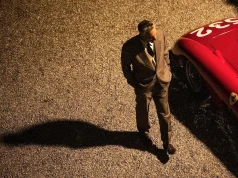
Please be silent behind the screen.
Backstage at the 1927 Hollywood premiere of his latest screen triumph, film star George Valentin — played with irresistible zest by Jean Dujardin — waits for the crowd’s response. Standing in front of the sign shushing the backstagers, he hears the applause. We only see it, The Artist being a silent film (or nearly) whose story begins in the late silent era. When Valentin takes his bow with his co-stars, female and canine, it’s clear this man’s oxygen is the love of a crowd.
The Artist exists also to be loved.
Writer-director Michel Hazanavicius (pronounced Ha-zahn-a-vish-us) has made a beguiling jape that takes this fictional character, an amalgam of Douglas Fairbanks Sr., John Gilbert and Gene Kelly’s Don Lockwood from Singin’ in the Rain, and presents him with every obstacle he can muster. The fickleness of the public’s changing taste; unemployment; a broken heart pushing him to the brink of tragedy. And then, after we’ve been through the wringer, a tap duet and out.
No wonder American audiences aren’t quite sure what to expect from the French import that premiered, triumphantly, at the 2011 Cannes Film Festival and has topped a majority of stateside critics’ prizes this month. Is The Artist a screwball comedy? A sentimental melodrama? A spoof? Serious?
What? Yes, yes, yes and yes. We may see Dujardin on the receiving end of an Academy Award come February. We may see Hazanavicius as well. There’s also a wonderful dog, played by a Jack Russell terrier named Uggie, who costars with Dujardin in Valentin’s swashbuckling adventures and is excellent, indeed life-saving company off screen.
The Artist is a pastiche with heart, sincere and rangy (too rangy in some ways). At the top of his profession, Valentin meets eager would-be starlet Peppy Miller, played by Berenice Bejo. She dreams of success, and as her stock rises at Kinograph Studios — John Goodman glowers and grins as the combustible studio head — Valentin’s stock plummets. He refuses to adapt to the onset of the talkies. He puts all his money into one last vanity showcase, darker in hue than his usual exotic diversions, and pays for it. But just when things look blackest. …
Corny, all the way. I have a few problems with The Artist, some of them wonky and period-specific. For one thing, the film puts no real priority on being period-specific (it spans 1927 to the early ’30s). Filmed in squarish, silent-film 1:33 ratio, Hazanavicius goes only so far in framing and propelling a given scene in a way evoking any particular filmmakers of the day, even the film’s acknowledged influences, including the lushly cinematic romances of Frank Borzage. The Artist jumps around stylistically and tonally and its use, in the dramatic climax, of Bernard Herrmann’s epic Vertigo score seems like a mistake. While many of the great late silent-era films were all over the place in their emotional content, the swing here from effervescent parody to stark, borderline masochistic tragedy is more of a lurch.
So that’s what’s wrong with The Artist, which hardly gets in the way of what’s right. Dujardin found big success in Europe with Hazanavicius on their “O.S.S.”
James Bond spoofs (Austin Powers-y, but more sophisticated), and it’s no surprise Dujardin and his zillion-dollar smile fall so effortlessly into this setting. The surprise is that the actor brings such sound dramatic instincts to the later passages (which can get a little pokey) detailing Valentin’s Star is Born bottoming-out. Bejo makes Peppy peppy, of course, but she’s winning and honest in both the character’s self-regard and her innate decency. James Cromwell is spot-on as Valentin’s loyal chauffeur, as loyal in his way as Uggie is in his.
My favorite scene comes just when we must invest fully in the love story if The Artist is to amount to more than a gimmick. It is a series of takes on a movie set wherein Dujardin and Bejo are seen playing around, enjoying each other’s company and then, miraculously, falling in love. The Artist comes back to this footage later, fruitfully. The musical score by Ludovic Bource doesn’t need the help from Herrmann and other sources; it’s beautiful on its own, and when the best of Bource’s themes (“Comme une roseie de larmes”) underscores the pathos, well … between that and Uggie, I was more or less in the bag. The PG-13 rating is faintly ridiculous. What’s on screen barely merits a PG, and The Artist may not be great art, but it’s pearly entertainment.
—MCT, Tribune Media Service Respond: [email protected]














